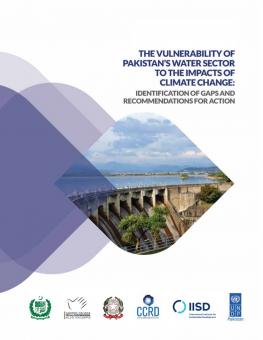
The Vulnerability of Pakistan's Water Sector to the Impacts of Climate Change: Identification of gaps and recommendations for action
This report explores the vulnerability of Pakistan’s water supply to climate change, noting potential changes in water availability, water demand, implications for key sectors, and strategies for addressing knowledge and capacity gaps.
This report presents the findings of a research project that identified potential climate change impacts on the future availability of water resources in the Indus Basin in Pakistan.
The project also identified implications for agriculture and health, projected changes in water demand and possible actions that could be taken to enhance Pakistan’s capacity to respond to these projected changes.
This project was led by the Ministry of Climate Change and the United Nations Development Program, in partnership with the Centre for Climate Research and Development at the COMSATS Institute of Information Technology in Islamabad, Pakistan, and the International Institute for Sustainable Development in Winnipeg, Canada.
This research project’s five main components included water supply analysis, water demand analysis, policy analysis, and outreach and communication to better understand existing capacity and identify gaps in research, data and water management practices.
The report concludes with recommendations related to research, policy implementation, infrastructure, and climate change adaptation to address uncertainty related to climate change and to increase social and economic capacity.
KEY FINDINGS
Climate change will have a limited impact on the total volume of water flowing in the Indus River Basin in the near and medium terms. Prior to the 2050s, climate change is more likely to change the timing of peak flow and increase the variability of flow volume in the Indus River, primarily due to less predictable precipitation (monsoon) patterns rather than changes in overall flow volume from glacial and nival (snow melt) sources.
There is a lack of existing knowledge regarding the complex hydrological regime of the Upper Indus Basin, limiting current capacity to estimate future water availability.
A projected increase in water demand means that water scarcity on a per capita basis will increase in Pakistan in the coming decades, even in the absence of climate change. Strong action is needed to better understand current and projected water demand patterns, and to improve water management practices, particularly in the agricultural sector.
Priorities for action to address these gaps include accelerating uptake of sustainable irrigation practices by smallholder farmers, strengthening post-secondary education in the area of climate change, establishing a repository of water data and analysis, and modernizing Pakistan’s streamflow monitoring network.
Participating experts
You might also be interested in
Making Every Drop Count: Pakistan’s growing water scarcity challenge
Can climate change risks spur needed action?
The looming “water crisis” in Pakistan needs due attention
Traditional security threats faced by Pakistan like extremism, terrorism, energy security, and external threats are largely discussed and debated in the policy circle as well as a political circle in Pakistan. However, non-traditional security threats are not getting due attention. Pakistan is facing numerous non-traditional threats and arguably the biggest threats are water scarcity and climate change.
Review of Current and Planned Adaptation Action in Pakistan
This report summarizes the climate risks and vulnerable sectors in Pakistan, providing an overview of climate change adaptation policies and initiatives introduced in response at the national and sub-national levels.
Border Carbon Adjustments: Trinidad and Tobago country report
This report consolidates, analyzes, and presents views and perspectives of stakeholders from Trinidad and Tobago on border carbon adjustment (BCA) schemes to contribute to the global debate on BCA good practices.